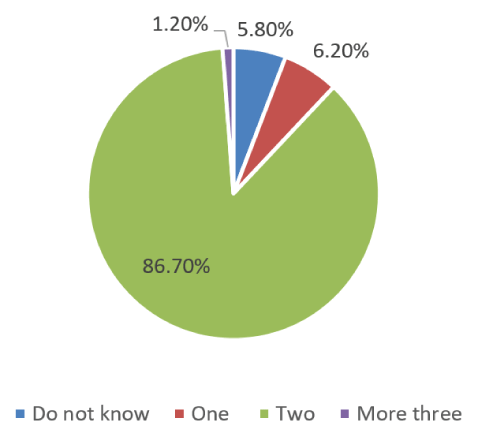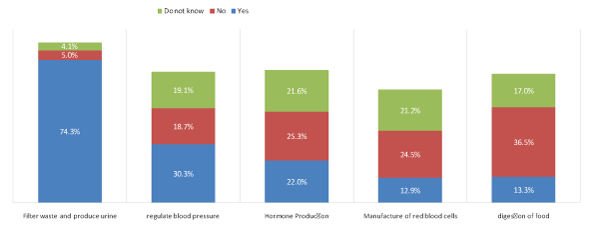
Figure 1: Knowledge of the number of kidneys and their anatomical location per individual.


Gael Honal Mahoungou1,2* Ange Clauvel Niama2 Armel Landry Batchi-Bouyou3 Daniel Tony Eyeni Sinomono1,2 Eric Ngadzali Ngabe1,2 Darius Mbou Essie2 Helena Botokoto Bothard1 Richard Loumingou1,2
1Department of Nephrology, University Hospital of Brazzaville, Republic of the Congo*Corresponding author: Gael Honal Mahoungou, Nephrologist, Department of Nephrology, University Hospital of Brazzaville, Republic of the Congo, Tel: +242 06 415 14 92; E-mail: mahoungougael@yahoo.fr
Introduction: Chronic renal failure (CRF) is a real health problem in Congo. It is with the aim of enacting preventive measures on the subject that we have undertaken to conduct a survey to assess the level of knowledge and perceptions of kidney disease among people with a higher level.
Patients and methods: This was a descriptive cross-sectional study from December 1st to 31st 2021 at Marien Ngouabi University. This study included teaching and non-teaching staff from Marien Ngouabi University with a higher level and willing to participate in the study. Data were analyzed by SPSS software (SPSS Inc. Chicago IL) version 16. The mean and standard deviation were calculated.
Results: A total of 241 individuals participated in the study. The average age was 37 ± 11 years, with extremes ranging from 32 to 65 years. Men were the most represented n=135 (56%) with a sex ratio M/W of 1.27. The number of kidneys per individual was known in 86% of cases (n=209). 188 (78%) participants knew at least one kidney function. Renal purifying function was known by 179 (74%) participants. The most common symptom of kidney disease reported by participants was edema of the lower limbs (41.1%).
Conclusion: Although the study was carried out in academia, knowledge about kidney disease remains very poor in the Republic of Congo. This may reflect a much lower level of knowledge within the general population. It is therefore important to carry out awareness-raising campaigns in universities on renal pathologies.
Kidney disease; Perceptions; Knowledge; Republic of Congo
Chronic Renal Failure (CRF) represents a real public health problem in the Republic of Congo as in all low-resource countries because of the complications it causes [1], the high cost of its treatment [2] in a context where there is not yet universal health coverage but also an insufficient number of nephrologists, thus limiting the supply of care [3].
Although very few data have been published to date in Congo, hospital studies indicate a frequency of CRF of 52.1% of patients admitted with a mortality exceeding 50% [4]. This high prevalence and mortality would be largely explained by the late consultation resulting to a frequency of more than 30% of dialytic emergencies among patients admitted to the department of nephrology at the University Hospital of Brazzaville for renal failure [5].
The frequency and severity of non-severe renal failure in Congo are unknown. To date, no public information campaign to raise Congolese awareness of kidney disease has yet been conducted. The tendency in the general population is rather to the ignorance of the symptoms of kidney diseases and the related treatments and it would seem that the level of education has no impact.
It is with the aim of enacting preventive measures on the subject that we undertook to conduct a survey to assess the level of knowledge and perceptions of kidney disease among people with a higher level.
This was a descriptive cross-sectional study from December 1st to 31st 2021 at Marien Ngouabi University, the only university in the Republic of Congo with a faculty of health sciences. Were included in this study the teaching and non-teaching staff of Marien Ngouabi University with a higher level and consenting to participate in the study. Faculty of Health Sciences teachers was excluded. A well-structured but simple questionnaire was administered to all participants by trained personnel. The French language was used.
The variables were age, sex, knowledge of the anatomical location of the kidney, its functions, and symptoms of chronic renal failure. Data were analyzed using SPSS software (SPSS Inc. Chicago IL) version 16. Mean and standard deviation were calculated for quantitative variables, and frequencies were used to represent qualitative variables.
A total of 241 individuals participated in the study. The average age was 37 ± 11 years, with extremes ranging from 32 to 65 years. Men were the most represented n=135 (56%) with an M/W sex ratio of 1.27.
The kidney was known in 95% of cases (n=231). The number of kidneys per individual was known in 86% of cases (n=209) (Figure 1).

Figure 1: Knowledge of the number of kidneys and their anatomical location per individual.
One hundred sixty (66.4%) participants reported the anatomical location of the kidney indicating the lower back, 26 (10.8%) did not know, 14 (5.8%) did not indicate location.
Knowledge about the functions of the kidneys: 188 (78%) participants knew at least one kidney function. Renal purification function was known by 179 (74%) participants, and unknown by 62 (26%) participants.
Renal function in the regulation of blood pressure was known by 73 (30%) participants, hormonal function by 53 participants (22%), regulation of hematopoiesis by 31 (13%), and 31 (13%) answered that the kidney participates in digestion (Figure 1).
Sixty-five participants (27%) reported being sufficiently informed about kidney disease. The source of information on kidney disease was a doctor (5.4%), a nurse (2.5%), the media (11.6%), or the entourage (7.5%).
Knowledge of symptoms: Symptoms of kidney disease reported by participants were lower limb edema (41.1%), hematuria (42.3%), oliguria (55.6%), facial puffiness (20.7%), high blood pressure (19.5%), and diarrhea (7.1%) (Figure 2).

Figure 2: Knowledge about kidney function.
Sixty-seven participants (27.8%) reported being a carrier or having already seen or heard of a patient suffering from kidney disease, of whom 33 (13.7%) were followed by a nephrologist and 23 (9.5%) benefited from regular biological monitoring.
The objective of this study was to analyze the knowledge and perceptions of kidney disease among staff at Marien Ngouabi University in the Republic of Congo. It appears that overall knowledge of kidney disease was poor among the participants in this study and only about 27% had heard of kidney disease. This can therefore be attributed to a lack or even insufficient awareness and health education on kidney disease in our study population. The provision of preventive information on these pathologies constitutes one of the essential public health interventions with regard to the high rate of lethality of renal insufficiency, and the difficult access to effective and quality care of renal failure.
Our results on the sources of information on kidney disease show that most participants (65%) believe they are sufficiently informed about kidney disease, however the main source of information found is the entourage. A similar study was conducted by Okaka EI, et al. in Nigeria [6] although mainly among undergraduates. Doctors topped the source of knowledge about kidney disease with 29.4%, followed by the media (28.9%) while schools had the least (3.9%). Health workers and the media must do more to educate the public about kidney disease.
More than half of the participants (66%) in our study believed that the kidneys are located in the lower back. In a study conducted in Nigeria by Okwuonu CG, et al. [7]. Fifty-two percent of respondents stated that the kidneys are located in the chest. A real confusion exists around the situation of the kidneys often attributed to the lower back rather than the lumbar pits.
Okaka EI, et al. [6] study revealed good knowledge of kidney location and kidney functions. This may be because their respondents were mostly undergraduate medical students. Comparatively, knowledge of the number of kidneys per person in our study population had a very high proportion (86%) compared to data from Okaka EI, et al. [6]. We found that fourteen percent did not know the total number of kidneys per individual compared to 5% by Okaka EI, et al. and 9.9% by Alebiosu CO, et al. [6,8]. This is paradoxical in view of the number of people with a higher level of education in our study carried out in a university environment. This is all the more surprising since more than half of the participants declared an erroneous anatomical location.
The participants had a good knowledge of renal functions with the exception of hematopoietic function. About 74% of participants in our study reported renal purifying function. This percentage is higher than that of 65.8% found in the study by Alebiosu CO, et al. [8]. However, 13.3% thought that the kidneys were involved in digestion.
Knowledge of the symptoms of renal insufficiency had relatively low proportions in our study with respectively 41%, 42%, 55%, 20%, 19% and 7% of the participants having cited as symptoms of renal pathologies: edema of the limbs lower legs, hematuria, oliguria, facial puffiness, high blood pressure and diarrhea. These results are high compared to the 23.9%, 13.5% and 0.7% respectively for lower limb edema, asthenia and facial puffiness reported by Alebiosu CO, et al. [8]. However, Okaka EI, et al. [6] also reported higher proportions with 61%, 68.1% and 49.2% respectively corresponding to lower limb edema, oliguria and asthenia. This showed a low knowledge of the most frequent symptoms during renal pathologies in academia in the Republic of Congo [9]. However, very few data have been reported in the literature on knowledge of symptoms such as nocturia, anemia, vomiting and hiccups [10-13].
This study was carried out in a university environment and there were participants with a higher level. The same study will have to be reproduced in the general population, both rural and urban, to estimate the extent of the ability to avoid kidney diseases for which the supply of care is unequally distributed in the Republic of the Congo.
Although the study was carried out in a university setting, knowledge of kidney disease remains very limited in the Republic of Congo. This may reflect a much lower level of knowledge among the general population.
None.
Download Provisional PDF Here
Article Type: RESEARCH ARTICLE
Citation: Mahoungou GH, Niama AC, Batchi-Bouyou AL, Eyeni Sinomono DT, Ngabe EN, et al. (2022) Knowledge and Perceptions of Kidney Disease among Workers of Marien Ngouabi University, Republic of the Congo. Int J Nephrol Kidney Fail 8(1): dx.doi.org/10.16966/2380-5498.223
Copyright: © 2022 Mahoungou GH, et al. This is an open-access article distributed under the terms of the Creative Commons Attribution License, which permits unrestricted use, distribution, and reproduction in any medium, provided the original author and source are credited.
Publication history:
All Sci Forschen Journals are Open Access